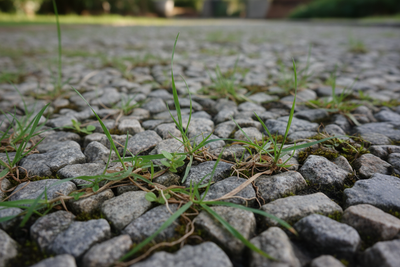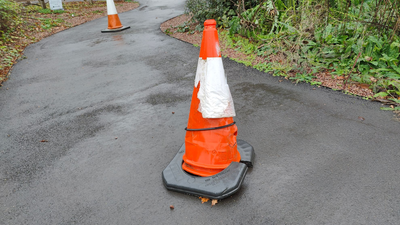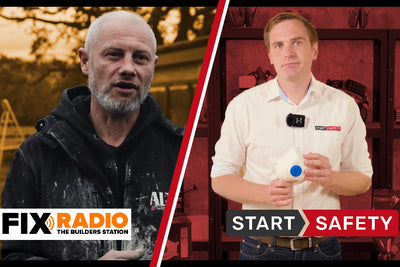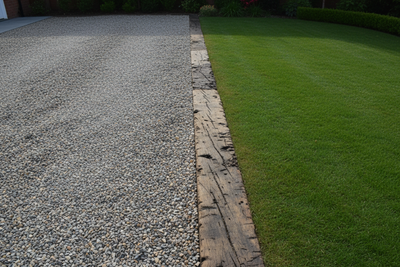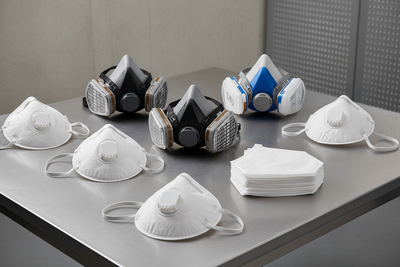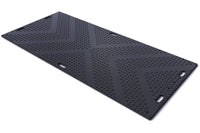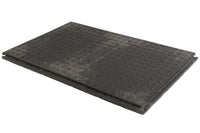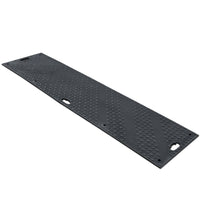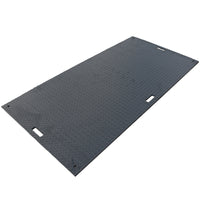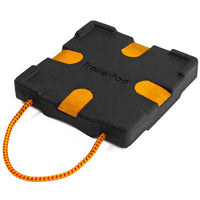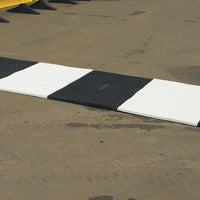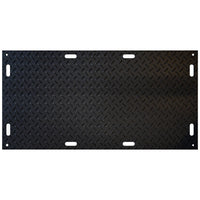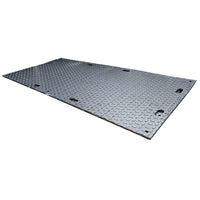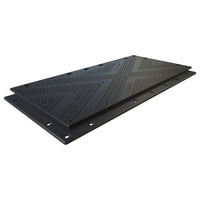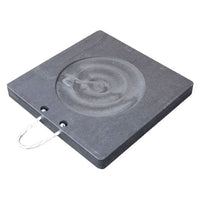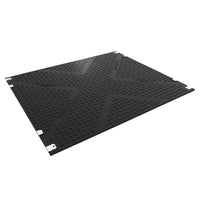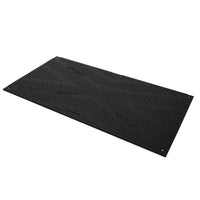Cheap vs Expensive Ground Protection Mats: Which is Right for Your Project?
Whenever construction, landscaping or an event takes place, it is essential to protect vulnerable surfaces from the increased traffic frequency and weight. This may be a surge in footfall as people move between different areas at an air show, or heavy lifting equipment moving across a field to install critical infrastructure.
When choosing the best method to protect delicate floor coverings, which most often are grass but can also be tarmac, block paving, or even marble floors, you need to check the suitability of the ground protection mat in terms of performance and, of course, budget.
We are frequently asked if a certain ground protection mat justifies its price point for a specific application. As with most things, the answer is not as simple as cheaper is better or more expensive is better. The reality is that almost all mats on the price spectrum have their place, and this is what we will be covering in this article: the great debate over "cheap vs. expensive ground protection matting."
What Are Ground Protection Mats Used For?
Ground protection systems are used in a vast number of roles. We have already mentioned a couple of applications above, but it is often surprising to people how many places they can be used and how good they are at their job when the correct system is used. Below, we have covered some of the main applications we see matting used for.
- Heavy Foot Traffic — On construction sites and at events, foot traffic can be surprisingly damaging to grassed areas, especially if it rains. Walkway mats are perfect for this; they can be deployed at choke points and gateways where foot traffic is at its most concentrated. Walkway mats need to have a high-traction top surface to ensure that people do not slip, but they do not need to be able to support the ultra-heavy loads that other matting systems can.
- Vehicle Traffic & Parking - When there is a seasonal increase in parking requirements at a theme park or event venue, there is no better alternative to the medium-duty mats that make up our car park matting. These versatile mats can even play a part when cars are displaced from a permanent car park whilst works are being carried out, allowing for safe and effective use of adjacent green spaces temporarily, all without vehicles getting stuck in a mud bath.
- Construction & Plant Traffic - When working in remote areas installing energy infrastructure, there is not always the luxury of an adjacent roadway; in fact, the nearest road is often 100-plus metres across a field from the area where the works are being carried out. Heavy-duty access matting is king here, supporting and ensuring that the ground is protected whilst also preventing expensive equipment from getting stuck in mud or even tipping over in extreme circumstances.
As you can see from these few further examples, the right matting system is critical for the safety of those working in the area, the efficiency of the site or event in general, and, of course, to prevent damage, which is inevitably expensive to repair.
Cheap Ground Protection Mats: Pros & Cons
Here, we will examine some pros and cons of cheap matting. It is important to remember that every application can have cheap and expensive matting within its price range, and the application ultimately frames each price range.
The pros of cheap ground protection mats:
- Lower upfront cost—A cheaper mat will immediately reduce your upfront costs, freeing up money for use elsewhere on the project.
- Often lighter in weight—with many mats, the cost is the material that goes into them, meaning cheaper mats are often lighter and easier for people to handle on-site. We will touch on this again later, though, as this is one rule that gets bent when you go to the ultra-heavy-duty end of the market.
- Perfect for light-duty applications—If you are putting a skip on your driveway and don't want to damage the surface or need to create a walkway across a grassed area for light foot and wheelbarrow traffic, then cheaper mats, Groundtrak, can make a lot of sense.
The cons of cheap ground protection mats:
- Shorter lifespan—Cheaper mats tend to have shorter lifespans than their more costly counterparts. This is normally due to the mats using cheaper or recycled blends of less consistent materials and fewer performance-enhancing additives.
- Less durable under heavy plants or vehicles—The cheaper materials and processes used to make the mats raise their heads again here, where the cost of mat production is reduced by using less energy-intensive or faster production methods, which do not always equate to a better-quality product.
- Less feature-rich—Cheaper mats tend to cut back on features to reduce tooling costs, so things like hand holds that make mats easier to move or bolt holes for interlocking are often absent.
- Warping and cracking—although this is not true for all cheaper mats, it certainly is the case for some particularly cheap products, where UV stabilisers and other additives that add weather resistance are not used.
- Limited traction and grip—Some cheaper mats remove costly machining processes or use different manufacturing methods, significantly reducing the traction on the mat's surface. This becomes evident when the mats are wet and applies to both foot and vehicle traffic.
- Not as suited for extreme terrain—Cheaper mats often struggle to balance flexibility and support, being either too stiff to conform to undulating terrain or too flexible to support heavy point loads.
Expensive Ground Protection Mats: Pros & Cons
Now we will look at the pros and cons of mats at the higher end of the price range, covering what common elements are present within the range, both good and bad.
The pros of expensive ground protection mats:
- Designed for long-term and repeated use—Prices at the higher end of the price range are generally more robust and designed for use across multiple sites or multiple customers (if you are hiring them out).
- Stronger load-bearing capacity—Better quality plastics and additives make these mats capable of dealing with the high loads that heavy plant and machinery can put on matting.
- Anti-slip surfaces and engineered grip—Premium mats tend to have extra or more time-consuming manufacturing processes that enhance traction. These can be simple things, such as sandblasting the moulds, or different pressing techniques that allow for deeper and more aggressive tread patterns.
- Lower cost per use over time—As these mats last longer, you will find that you can use them more frequently, diluting the original outlay and giving a better return on investment every single time they are deployed.
- Resale value—If you buy a known brand of mat, such as Euromat or Tufftrak, you will find that at the end of their life, most sellers will buy them back, or you can sell them on and recuperate even further costs from the original outlay. This is nearly impossible to do with non-brand mats.
- Ease of handling—Some of the top-tier mats use expensive materials internally to make them far lighter than cheaper alternatives. This tends to be on the extra heavy-duty end of the spectrum for bog mats that can be buoyant. These premium materials do, however, come at a cost that inflates prices.
The cons of expensive ground protection mats:
- Higher upfront investment - The initial outlay when buying a quality mat compared to a cheaper alternative can be significantly higher, as much as 100% more in some cases, meaning buying quality may mean tightening budgets elsewhere.
- Heavier, so might need lifting equipment or more people to install—Some of the heaviest duty mats can weigh in excess of 250kg, so they will require lifting equipment to get into place. That said, higher-quality, smaller mats may weigh a little more, but they tend to have handholds and other features to make handling easier.
- May be overkill for small, one-off jobs—If you are deploying a footpath for a single-day event with a small turnout, a top-tier, heavy-duty ground protection mat will very likely far exceed the performance needed and cost in excess of 30x more than its budget-friendly footpath mat alternative.
When Should You Choose Cheap vs Expensive Mats?
Of course, each end of the pricing market in ground protection mating exists for a reason; they all still serve a purpose. Knowing when to go for a budget mat and when to spend a little more is where you can really deliver the best value for your purchase.
When cheap mats make the most sense.
Assuming you have narrowed in on a specification that fits your use case, for example, you are not trying to run a digger over a mat only designed for foot traffic, the following scenarios and examples are often a safe bet with cheaper matting.
- DIY use—Are you doing a project around the house and need to move a mini digger across the garden without chewing up your grass? Then this is a perfect use case for a cheaper mat, as most properly designed and specified mats will do this job without issue.
- If you are putting a skip on a client's driveway and want to prevent the skip from scuffing or marring the surface, a cheaper mat will work just fine here, too (and it won't fill up with water like plywood!).
- Again, this is a great choice for a cheaper matting system if you are holding an event and need to create a flat and stable surface for people to stand on under a gazebo.
Where expensive mats make the most sense;
The same caveat applies here: You need to get the mat that is correctly specified for the job. Even the most expensive footway or walkway mat won't work if you lay it across a boggy field and send hundreds of cars over it.
- Construction - If you are a builder or civils company, then quality matting is a punishment of being laid out time and time again between different sites. It also comes with less risk of failure, which could grind a site to a halt costing £ 1000's.
- Hire Industry—If you are hiring out matting, then you want to get mats that last as long as possible and are as hard-wearing as possible, so there is less likelihood of failure and unhappy customers wanting a refund or compensation for delays or damages. Expensive branded mats can also be sold at the end of their rental life, providing a good amount of money in return for investing in new stock.
- Large events—When holding large events, you need quality event matting, and it is worth spending the extra to ensure you are not held liable for someone slipping over or tripping. Even if it was not the fault of the mat stock, having decent, well-maintained matting will show that you provided the best available and minimise the risk of compensation claims.
Cost-Effectiveness Over Time
As we have touched on a few times, buying quality matting can offer a far better cost effectiveness over time, yes there is a more significant upfront cost, but when you consider a quality mat may last as much as 10 times longer than a cheap alternative, you can quickly see where the lifetime value can be realised. Couple this with the end-of-life resale value if they are still in usable condition when you no longer require them, and you will see yourself financially better off by investing in quality mats in most instances.
Another argument is, "Why not just rent it?" While yes, in some situations, rental can make sense, on large and long-duration projects, the rental costs can quickly stack up. We will even offer to buy back many of our premium mats, such as the EuroMat or TuffTrak mats, at the end of your project, meaning that should the job overrun, you are shielded from additional rental fees as you are just delaying when we will repurchase them.
Top Products to Consider in Each Category
- Euromat—A great quality mat that delivers performance at a great price point. Made from HDPE and with a loading capacity of 80 tonnes and a large form factor of 1200mm x 2400mm, this is a great premium mat we stand by every time for vehicle and foot traffic. Learn more about the Euromat.
- Economat—This mat is a great budget offering. While not as strong as the previously mentioned mat, it has a lower price point. It forgoes the gripped texture on one side, which reduces the cost, and is made from a more flexible material while maintaining the same 1200mm x 2400mm form factor. It has a load-bearing capacity of 30 tonnes. Learn more about the Economat.
-
Grountrak Mat - This budget offering is a great mat that still packs a punch, where as the previous two mats bolt together, this mat interlocks by overlapping the adjacent mat. It is a smaller form factor at only 1200x800mm, meaning you need more of them, but it is easy to handle and deploy even for a single worker. It is ideal for creating temporary walkways or roadways for light traffic. It has a load rating of 20 tonnes. The Groundtrak mat is made entirely of recycled PVC. Learn more about the GroundTrak mat.
Still Not Sure? Our Experts Can Help
We understand that choosing the right matting system can not only represent a significant outlay and expense but is also a relatively complex topic, more so than it may initially seem. This is why we have a team of experts waiting to help with free advice and guidance, ensuring you get the right mat system for your needs.
You can contact them during normal business hours on 01905 794 875 or at any time by using the form on our contact page. We know how to transport these mats quickly from our extensive stocks, ensuring your site is as safe as possible. As mentioned, we can even offer buy-backs on many of our matting lines, ensuring that when you are done with them, you already have a buyer lined up!
Conclusion
In summary, picking the right ground mat is important and not something that is always based on the value of the mat. To get the most out of your matting and avoid a costly mistake, here are some of the key takeaways;
- The correct specification of mats is by far the most important aspect of establishing a safe site, event, or project.
- If you are using matting long-term, for hire, or for operationally critical applications, then you really should look for premium offerings that will not let you down when you need them most.
- If you are doing work at home, for a small project, or using a mat for a lightly trafficked area on a site, a cheaper mat will likely suffice and still offer good value for money.
You can find out more about the vast range of matting we offer in our matting collection, where you will find even more information. Don't forget we are always available to assist you in your buying requirements.
- Author
